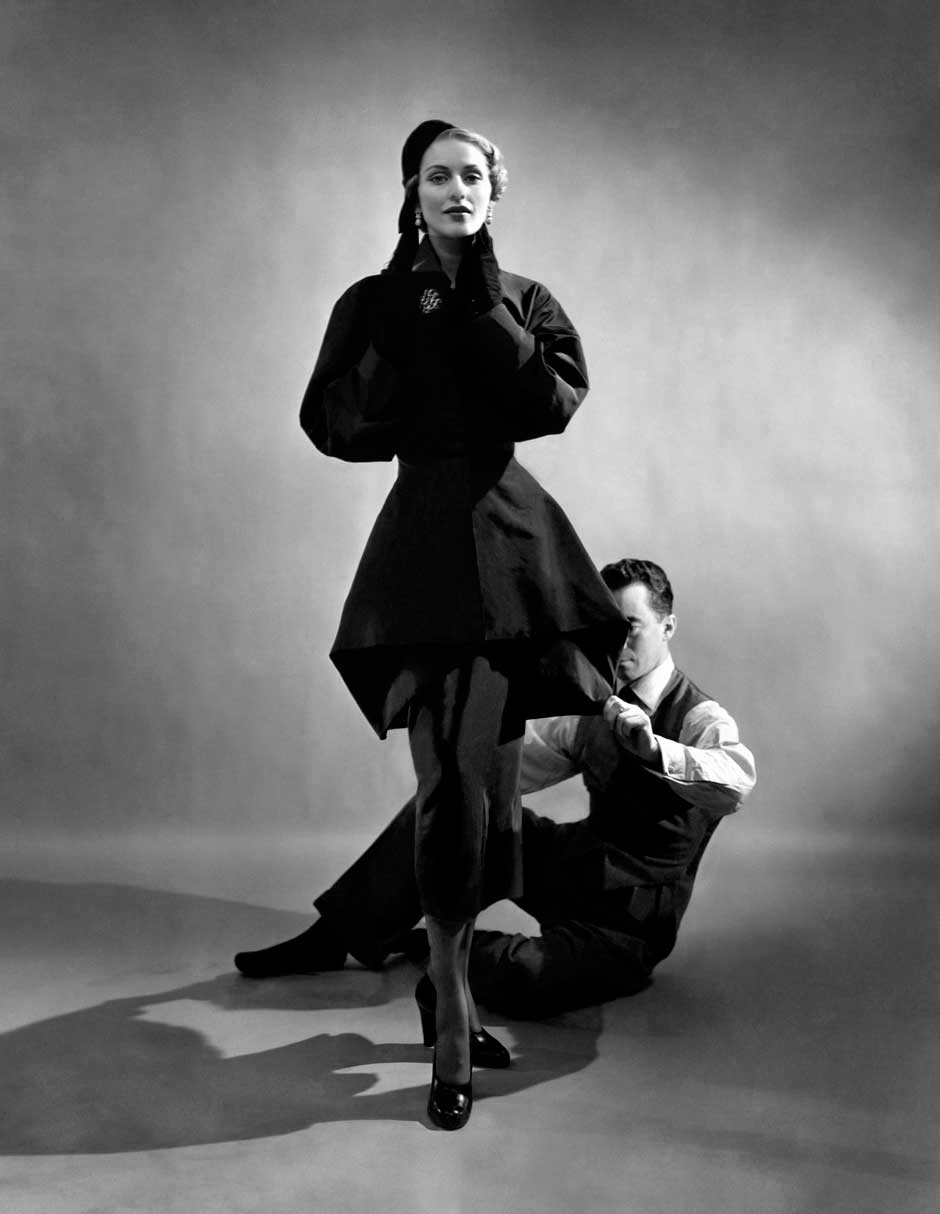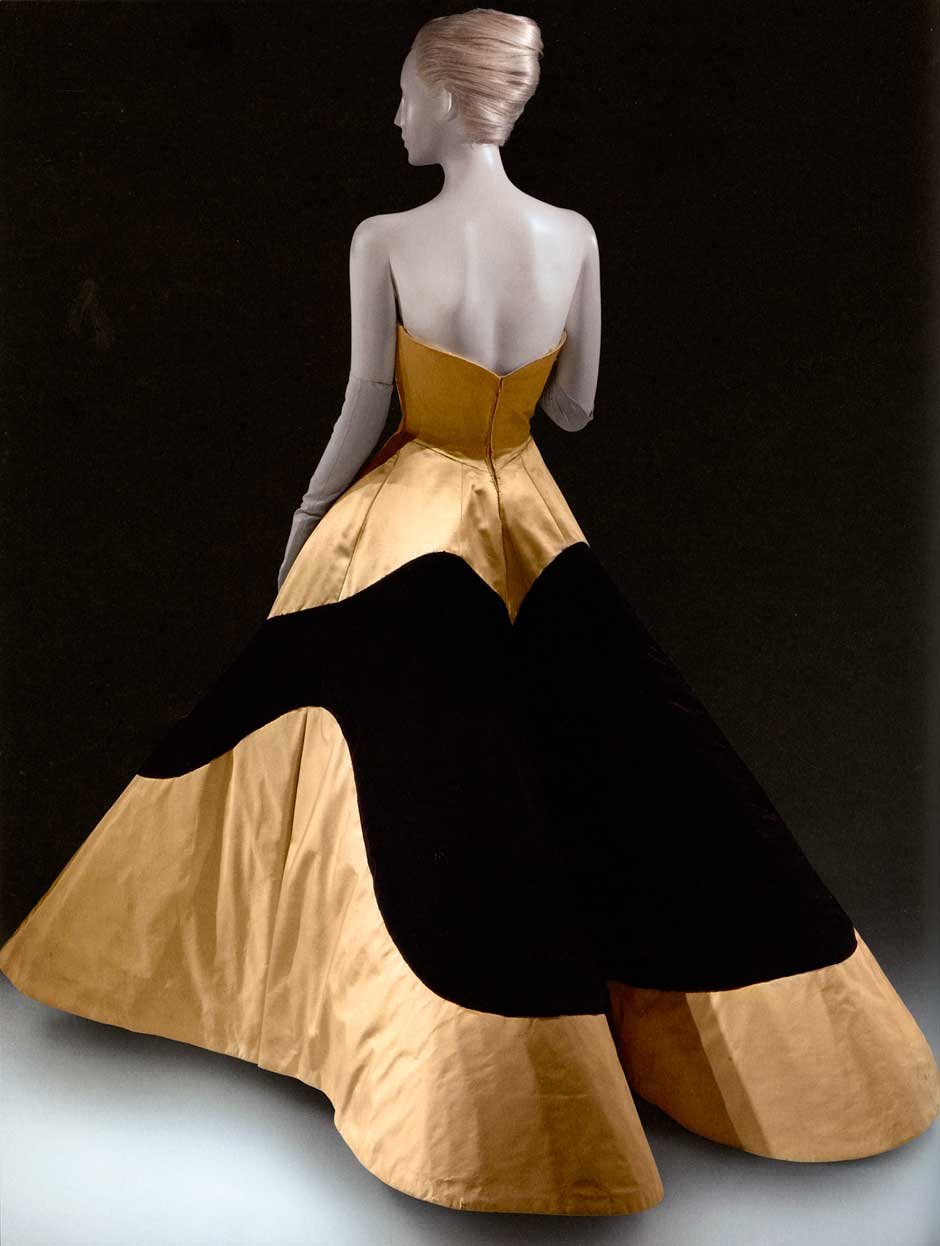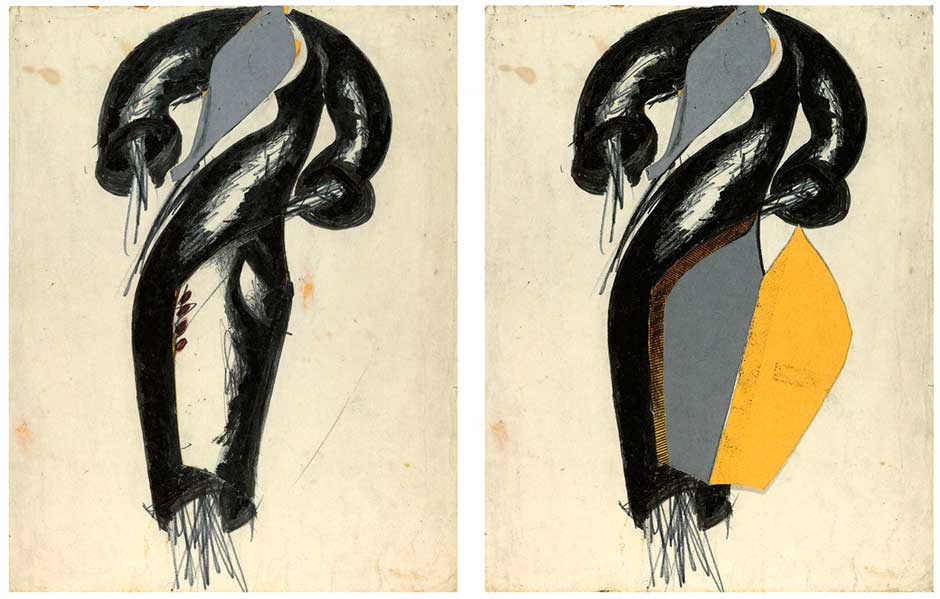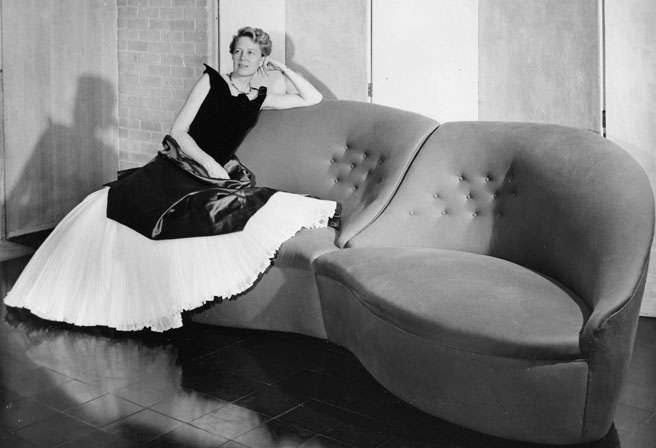In the early 1980s, my wife and I became intrigued by the geometrically inspired “architectural” clothing of a new Dutch-born designer, Ronaldus Shamask. But when I told my colleague Babs Simpson, a longtime Harper’s Bazaar and Vogue editor, about this discovery she replied, unimpressed, “Well, for that sort of thing there was only Charley James.”
Indeed, the highly constructed garments created by the Anglo-American Charles James (1906–1978) make Shamask’s striking but lightweight pieces seem more like origami than architecture. Some of James’s evening dresses are such feats of fabric engineering that they can stand up by themselves.
This is all the more striking in view of the era in which he reached the height of his career. During the 1930s, women’s clothing was generally limp and clinging, but James, pursuing his own innovations in these years, was able to achieve strong, sculptural shapes with stiff materials like grosgrain and taffeta that stood away from the body.
I’d known about this Anglo-American prodigy from the photographer Cecil Beaton’s glittering interwar diaries, as well as from depressing accounts of James’s sad final years. Deemed the supreme couturier of their generation by Cristóbal Balenciaga and Christian Dior, he ended up in poverty and drug-addled squalor at Manhattan’s Chelsea Hotel. There he subsisted on handouts from the jewelry designer Elsa Peretti and fitted dresses on the fashion illustrator Antonio Lopez, who returned the compliment by making dynamic drawings of the by-then-forgotten couturier’s work, helping to revive his reputation.
Yet only when I saw the Brooklyn Museum’s revelatory 1982 retrospective The Genius of Charles James did I fully comprehend why he’d attained cult status among style insiders. The museum had received an incomparable cache of his couture from the designer himself, who was eager to secure a place in design history, and he encouraged his favorite clients to donate their Jameses as well. His decades-old creations, with their rich jewel-toned fabrics displayed against fresh white backgrounds, looked both contemporary and timeless.
In 2008, these holdings were transferred to the Metropolitan Museum of Art, along with the entire fashion collection of the Brooklyn Museum, which, in financial straits, could no longer maintain it. Alas, the new Met exhibition, “Charles James: Beyond Fashion,” which opens today, is not as exhilarating as its 1982 precursor.
Organized by Harold Koda and Jan Glier Reeder, the current survey is split between galleries at opposite ends of the sprawling museum (including the newly renamed Anna Wintour Costume Center), with scant indication that the show continues in a second space, or any apparent logic to the division of displays. Furthermore, the stygian black-on-black installation by Diller Scofidio + Renfro— which features disorienting floor-to-ceiling mirrored walls like some 1940s nightclub—is so dark that several black and deep-gray outfits are virtually indecipherable, with many labels confusingly distant from the objects they identify. Conservation requirements for fabric display require light control, but the Met’s blockbuster 2011 Alexander McQueen retrospective was dazzlingly bright by comparison.
When James was born—in Sandhurst, Berkshire to a British army officer and a Chicago heiress—upper-class ladies were tightly corseted into hourglass figures, swathed in layers of undergarments, and weighed down under cartwheel-sized hats piled with feathers, fabric flowers, and fake fruit. By the time he was kicked out of Harrow at sixteen for what he later called a “minor escapade,” women had embraced a freer silhouette with a looser waist and shorter skirts, and topped their bobbed hairdos with trim little cloches.
After his expulsion, James’ mother finagled him a job with a Chicago utilities firm, where his drawing skills got him assigned to the architecture department. There—the closest he came to formal design education—he learned structural concepts that would undergird his approach to fashion, such as combining materials that enable one fabric to support another. In 1926 he began crafting sculptural felt hats, and shifted from millinery to frocks with precocious éclat. He became a darling of London’s smart set, where his polished manners and social connections enabled him to be treated as a gentleman, not a tradesman.
He labored obsessively to achieve his crisply outlined effects, and combined scientific seriousness with a relentless work ethic. Throughout the 1930s he triangulated among his couture salons in New York, London, and Paris until he settled for good in Manhattan with the outbreak of war in Europe.
James’s biomorphic compositions are epitomized by his down-filled satin evening jacket (1938), a gracefully curvilinear precursor of today’s sporty anoraks. Most celebrated of his organic designs was the strapless Clover Leaf dress (1952–1953), with a flaring, quatrefoil ankle-length skirt that undulated as its wearer walked and lilted when she danced. In addition to such evening showstoppers, James produced practical daywear, including his Taxi dress (1929), a sexy sheath that could be slipped on (and presumably off) in the backseat of a cab.
Advertisement
His technical grasp of tailoring was unparalleled, allowing him to devise a virtuoso series of interchangeable elements—sleeves, bodices, and skirts—that could be variously recombined into harmonious ensembles. Flaring dolman sleeves and a cowl collar, for example, would give an entirely different feel to a billowing skirt than fitted arms and a bateau neckline. James understood the innate draping qualities of specific textiles better than any of his peers; he preferred, as he said, to “make the [fabric’s] grain do the work.”
By 1950, James was attracting a devoted transatlantic coterie that included Anne, Countess of Rosse, Grace Dudley, Babe Paley, and Gloria Vanderbilt. He found an ideal client in Dominique de Menil, the French-born oil-equipment heiress and art collector who was so enraptured by his dresses that she asked him to decorate the Houston house (1948–1951) she and her husband commissioned from Philip Johnson. This redbrick International Style shoebox was a dry affair, and though Johnson balked at having a dressmaker doing the interiors, James’s felt-covered walls in deeply saturated colors and curvaceous upholstered seating (notably his Butterfly sofa) transformed it into one of postwar America’s most striking residences.
Such indulgent patrons aside, James’s later career was undermined by his incorrigibly irascible nature. He told one rich supplicant, “I couldn’t possibly make anything for a frump like you. Why, you can’t even walk properly.” He picked fights with supportive editors and admiring curators, and though he landed several potentially lucrative contracts with manufacturers and retailers, those affiliations inevitably ended in tears, or lawsuits.
His self-destructive impulsiveness, paranoia, and litigiousness worsened after he officially retired in 1958 and fell into the clutches of Max Jacobson, the notorious “Dr. Feelgood” who hooked numerous celebrity patients on amphetamines disguised as vitamins. James broke with his old Harrow chum Beaton over some imagined slight, and when the rising fashion star Halston hired him as a consultant, James accused him of ripping off his ideas and severed this financial lifeline.
James’s conviction that clothing is an art form holds irresistible appeal for more recent, commercially impelled designers, who regularly invoke his memory even while (for the most part) falling far short of his technical prowess. Thus, despite the Met’s less than ideal presentation, few visitors will exit this tribute to Charles James without a deep respect for the master builder of modern fashion.
“Charles James: Beyond Fashion” is on view at the Metropolitan Museum of Art through August 10.






